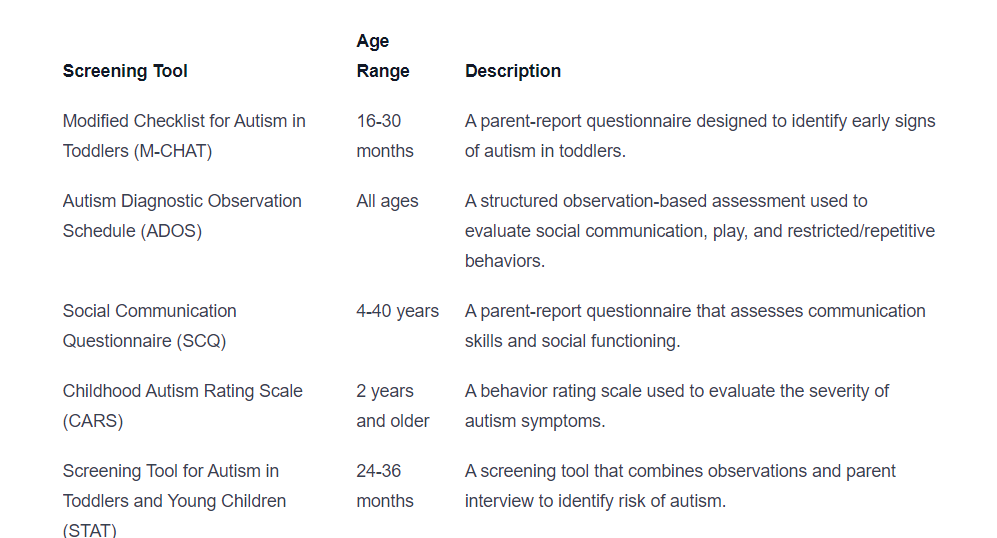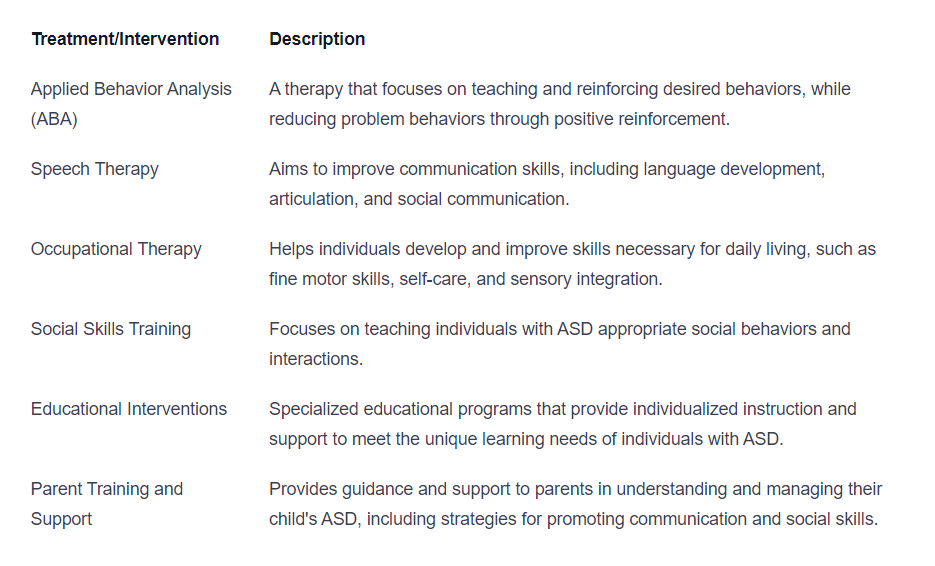Autism Screening and Assessments
Discover the comprehensive guide to autism screening & assessments. Learn about the process, professionals involved, and interpreting the results.

Understanding Autism
Autism is a neurodevelopmental disorder that affects individuals in various ways. It is characterized by challenges in social interaction, communication, and restricted or repetitive behaviors. Understanding autism is crucial in order to provide appropriate support and interventions for individuals on the autism spectrum.

What is Autism?
Autism, also known as Autism Spectrum Disorder (ASD), is a complex condition that affects the brain's development. It is a spectrum disorder, which means that individuals can experience a wide range of symptoms and abilities. Autism is typically diagnosed in early childhood, although some individuals may receive a diagnosis later in life.
Signs and Symptoms of Autism
The signs and symptoms of autism can vary from person to person, but there are common characteristics that may indicate the presence of autism. These include difficulties in social interaction, such as challenges in understanding and responding to social cues, difficulty in maintaining eye contact, and limited interest in sharing experiences with others.
Communication difficulties are also common in individuals with autism. They may have delayed speech development, difficulty initiating or maintaining conversations, or using repetitive language. Some individuals may also have trouble understanding nonverbal communication, such as gestures or facial expressions.
In addition to social and communication challenges, individuals with autism may engage in repetitive behaviors or have specific interests. They may have strict routines or rituals, exhibit repetitive movements like hand flapping or rocking, or have intense focus on particular topics or objects.
Importance of Early Detection
Early detection of autism is crucial for several reasons. Identifying autism early allows for timely interventions and support to be provided, which can significantly improve long-term outcomes for individuals on the autism spectrum. Early intervention can help develop social, communication, and behavioral skills, and may reduce the need for intensive support later in life.
Furthermore, early detection allows for access to appropriate educational resources and therapies that can support the individual's learning and development. It also provides an opportunity for families to better understand their child's needs and seek guidance from professionals who specialize in autism.
By recognizing the signs and symptoms of autism and seeking a comprehensive assessment, individuals can receive the support they need to thrive and reach their full potential.
Understanding autism, its signs and symptoms, and the importance of early detection lays the foundation for effective autism screening and assessments. The next sections will delve into the purpose and common tools used in autism screening, as well as the assessment process and professionals involved in the evaluation.
Autism Screening
When it comes to autism, early detection and intervention play a crucial role in promoting the well-being and development of individuals on the autism spectrum. Autism screening is an important step in identifying potential signs and symptoms of autism and determining the need for further assessment. In this section, we will explore the purpose of autism screening and some common screening tools used in the process.
Purpose of Autism Screening
The primary purpose of autism screening is to identify individuals who may be at risk for autism spectrum disorders (ASD). Screening aims to detect early signs and symptoms of autism, allowing for timely intervention and support. Early detection can lead to better outcomes and improved quality of life for individuals on the spectrum.
Screening is typically conducted in various settings, such as pediatric clinics, schools, and community health centers. It involves the use of structured questionnaires and observations to gather information about a child's behavior, communication, social interactions, and developmental milestones.
Common Autism Screening Tools
Several standardized screening tools are used by healthcare professionals and educators to assess the likelihood of autism. These tools help in identifying children who may require further evaluation. Here are some commonly used autism screening tools:

It's important to note that while these screening tools can provide valuable insights, they do not provide a definitive diagnosis of autism. If a child screens positive on an autism screening tool, further assessment by qualified professionals is typically recommended to confirm the diagnosis.
By conducting autism screening, healthcare professionals and educators can identify individuals who may require further assessment and intervention. Early detection through screening plays a crucial role in promoting the optimal development and well-being of individuals on the autism spectrum.
Autism Assessments
When it comes to autism, assessments play a crucial role in diagnosing and understanding the condition. There are two main types of assessments commonly used: comprehensive diagnostic evaluations and multidisciplinary assessments.
Comprehensive Diagnostic Evaluations
Comprehensive diagnostic evaluations are thorough assessments conducted by professionals specializing in autism. These evaluations involve a comprehensive examination of the individual's developmental history, behavior patterns, and social interactions. The purpose is to determine whether the individual meets the diagnostic criteria for autism spectrum disorder (ASD) as outlined in the Diagnostic and Statistical Manual of Mental Disorders (DSM-5).
During a comprehensive diagnostic evaluation, various assessment tools and techniques may be utilized, including:
- Diagnostic interviews: These interviews involve gathering information from the individual and their caregivers to assess the presence of autism-related symptoms and behaviors.
- Behavioral observations: Observations are conducted in various settings to assess social communication skills, repetitive behaviors, and interactions with others.
- Developmental assessments: These assessments evaluate the individual's developmental milestones and identify any delays or atypical patterns.
- Psychological assessments: Psychological tests may be administered to assess cognitive abilities, language skills, and adaptive functioning.
The comprehensive diagnostic evaluation helps professionals form a comprehensive understanding of the individual's strengths, challenges, and specific needs. It serves as the foundation for an accurate diagnosis and guides the development of appropriate treatment and intervention plans.
Multidisciplinary Assessments
Multidisciplinary assessments involve a team of professionals from different disciplines working together to evaluate various aspects of autism. This collaborative approach ensures a comprehensive assessment that considers multiple perspectives and areas of expertise.
The multidisciplinary assessment team typically includes professionals such as:

By combining the expertise of professionals from different fields, multidisciplinary assessments provide a holistic view of the individual's strengths, challenges, and specific needs. This collaborative approach helps in developing a comprehensive intervention plan tailored to the individual's unique profile.
Both comprehensive diagnostic evaluations and multidisciplinary assessments are vital components of the assessment process for autism. They provide valuable insights into the individual's condition, facilitate accurate diagnosis, and guide intervention planning to support individuals with autism in reaching their full potential.
Professionals Involved in Autism Assessments
When it comes to autism assessments, a team of professionals with specialized expertise is typically involved in the process. These professionals work collaboratively to gather information, evaluate the child's development, and provide a comprehensive assessment. Here are the key professionals commonly involved in autism assessments:
Psychologists
Psychologists play a vital role in autism assessments. They are trained in evaluating behavior, cognitive abilities, and social-emotional functioning. Psychologists administer and interpret standardized tests, conduct interviews, and assess the child's overall psychological well-being. They contribute valuable insights into the child's behavior and provide a comprehensive understanding of their cognitive and emotional functioning.
Developmental Pediatricians
Developmental pediatricians are medical doctors with expertise in child development and behavior. They specialize in diagnosing and treating developmental disorders, including autism. Developmental pediatricians conduct thorough medical evaluations, review the child's developmental history, and assess their physical health. They collaborate with other professionals to gather a holistic view of the child's development and help determine an accurate diagnosis.
Speech-Language Pathologists
Speech-language pathologists (SLPs) focus on evaluating and treating language and communication difficulties. In autism assessments, SLPs assess the child's language skills, including speech production, comprehension, and social communication abilities. They also evaluate non-verbal communication skills, such as gestures and eye contact. SLPs play a crucial role in identifying language delays and determining appropriate interventions to support communication development.
Occupational Therapists
Occupational therapists (OTs) specialize in assessing and addressing challenges related to sensory processing, fine motor skills, self-care, and daily living activities. In autism assessments, OTs evaluate the child's sensory integration, motor coordination, and adaptive skills. They assess how the child interacts with their environment and identify any difficulties that may impact their daily functioning. OTs provide insights into the child's sensory and motor abilities and recommend strategies to enhance their participation and independence.
These professionals work together to gather information from various sources, including parents, caregivers, and teachers, to form a comprehensive assessment. By combining their expertise, they provide a holistic understanding of the child's strengths, challenges, and needs. This collaborative approach ensures a thorough evaluation and facilitates the development of appropriate treatment and intervention plans tailored to the child's unique profile.
The Assessment Process
Once autism screening indicates the need for further evaluation, the assessment process begins. This comprehensive process involves various stages to gather information and make an accurate diagnosis. The assessment process typically includes an initial consultation and history taking, observations and behavioral assessments, standardized testing, as well as developmental and medical assessments.
Initial Consultation and History Taking
The assessment process usually starts with an initial consultation and history taking. During this phase, a healthcare professional, such as a psychologist or developmental pediatrician, will meet with the individual being assessed and their family. The purpose of this consultation is to gather detailed information about the individual's developmental history, behavior patterns, and any concerns or observations from the family. This information provides valuable insights and helps guide the assessment process.
Observations and Behavioral Assessments
Observations and behavioral assessments are crucial components of the assessment process. These assessments involve observing the individual's behavior in various settings, such as at home, school, or during therapy sessions. The healthcare professional may use structured observation tools and checklists to gather information about the individual's social interactions, communication skills, repetitive behaviors, and other relevant behaviors associated with autism. These observations provide valuable information about the individual's strengths and challenges in different situations.
Standardized Testing
Standardized testing is an important part of the assessment process. It involves the use of validated tests and assessments to measure specific areas of functioning, such as cognitive abilities, language skills, and adaptive behaviors. These tests are administered in a standardized manner, ensuring reliability and comparability of results. The scores obtained from these tests help in understanding the individual's strengths and weaknesses and contribute to the overall diagnostic evaluation.
Developmental and Medical Assessments
In addition to observations and standardized testing, developmental and medical assessments are often conducted as part of the comprehensive evaluation process. Developmental assessments involve assessing various aspects of development, such as motor skills, sensory processing, and play skills. These assessments help in understanding the individual's overall developmental profile and identifying any areas of concern.
Medical assessments may be conducted to rule out any underlying medical conditions that may be associated with autism or to assess any co-occurring medical issues. These assessments may involve a physical examination, genetic testing, or other medical evaluations as deemed necessary by the healthcare professional.
The assessment process is a thorough and comprehensive evaluation that combines information from multiple sources and assessments. It aims to provide a holistic understanding of the individual's strengths, challenges, and developmental profile, leading to an accurate diagnosis and appropriate intervention planning.
Interpreting the Results
Once the autism screening and assessments are completed, the next step is to interpret the results. This involves analyzing the findings from the evaluation process to determine the diagnosis and establish a plan for treatment and intervention.
Diagnosis and Diagnostic Criteria
Interpreting the results of autism assessments involves considering various factors, including the diagnostic criteria for autism spectrum disorder (ASD). The diagnostic criteria are outlined in the Diagnostic and Statistical Manual of Mental Disorders (DSM-5), which is widely used by professionals in the field.
The DSM-5 criteria for ASD include persistent deficits in social communication and interaction, as well as restricted, repetitive patterns of behavior, interests, or activities. These criteria are used to determine whether an individual meets the requirements for an ASD diagnosis.
It's important to note that the diagnostic process is comprehensive and involves considering multiple sources of information, including observations, assessments, and developmental history. The assessment results are carefully analyzed by qualified professionals to arrive at an accurate diagnosis.
Treatment and Intervention Planning
Once a diagnosis of autism spectrum disorder (ASD) is made, the next step is to develop a comprehensive treatment and intervention plan. The specific needs and goals of the individual with ASD will guide the development of this plan.
Treatment and intervention for individuals with ASD often involve a multidisciplinary approach, where professionals from various fields collaborate to address the unique challenges and strengths of the individual. The treatment plan may include a combination of therapies, educational interventions, and support services tailored to the individual's specific needs.
The table below provides an overview of some common treatment and intervention strategies for individuals with ASD:

It's important to remember that each individual with ASD is unique, and therefore, the treatment and intervention plan should be tailored to their specific needs and strengths. Regular monitoring and reassessment of progress are essential to ensure that the chosen strategies are effective and can be adjusted as needed.
By interpreting the results of the assessments, professionals can provide individuals with ASD and their families with valuable insights into their strengths and challenges. This allows for the development of a comprehensive treatment and intervention plan that supports their overall well-being and maximizes their potential for growth and development.
Interpreting the Results
Once the autism screening and assessments have been conducted, it is essential to interpret the results accurately. This step plays a crucial role in understanding the individual's diagnosis and developing an appropriate treatment and intervention plan.
Diagnosis and Diagnostic Criteria
Interpreting the results of autism assessments involves evaluating the individual's performance on various measures and comparing them to established diagnostic criteria. These criteria are typically based on internationally recognized diagnostic manuals such as the Diagnostic and Statistical Manual of Mental Disorders (DSM-5) or the International Classification of Diseases (ICD-11).
The diagnostic criteria typically include a combination of social communication and interaction deficits, as well as restricted and repetitive patterns of behavior. The individual's assessment results are carefully reviewed to determine if they meet the diagnostic criteria for autism spectrum disorder (ASD).
It's important to note that autism is a spectrum disorder, meaning that individuals may present with a wide range of symptoms and severity. The results of the assessments help professionals determine where an individual falls on the spectrum and provide insights into their unique strengths and challenges.
Treatment and Intervention Planning
Interpreting the results of autism assessments is not solely about reaching a diagnosis. It is also about understanding the individual's specific needs and developing a comprehensive treatment and intervention plan tailored to their requirements.
The assessment results provide valuable information about the individual's strengths and weaknesses, communication abilities, cognitive functioning, and adaptive skills. This information guides professionals in selecting appropriate interventions and therapies to address the individual's specific challenges.
Treatment and intervention plans for individuals with autism often involve a multidisciplinary approach, combining various therapies such as Applied Behavior Analysis (ABA), speech therapy, occupational therapy, and social skills training. The assessment results help professionals identify the most effective strategies and interventions to support the individual's development and enhance their quality of life.
By carefully interpreting the results of autism screening and assessments, professionals can provide individuals with the necessary support and interventions to help them reach their full potential. It is a collaborative process involving the individual, their family, and a team of professionals working together to create a comprehensive and individualized plan for their unique needs.
Sources
https://autism.org/screening-assessment/
https://childmind.org/article/what-should-evaluation-autism-look-like/
Similar articles
We’re here to help you

Our team is here to assist you in this process. Contact us for any assistance.
it’s easy to apply
We Accept Most Insurances
Our in-network insurance partnerships make ABA therapy more accessible to families throughout our service areas.







Our Insurance Process
We'll request your insurance details to help us verify your plan's coverage for ABA therapy. Once we've received this information, we'll walk you through your benefits, including copayments, deductibles and out-of-pocket maximums, so you know what to expect in advance.
Our team will then handle the preauthorization and all the necessary paperwork.
.svg)





















.jpeg)


































.jpeg)




.jpeg)







.jpeg)











.jpeg)
















